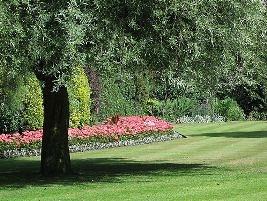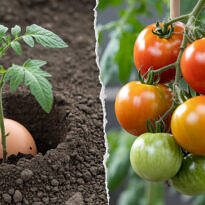In the realm of landscape design, few styles hold as much charm and enduring appeal as the English Garden. Rooted in history and revered for its natural elegance, this iconic style has captured the hearts of gardening enthusiasts and novices alike. In this comprehensive exploration, we’ll delve into the essence of the English Garden, uncover its origins, delve into its defining features, discuss plant selections, and appreciate its contemporary relevance. Join us on this journey through the lush pathways and captivating narratives that define the enchanting world of English Gardens.
The Origin Story: A Journey into Revolutionary Ideals

The inception of the English Garden can be traced back to a pivotal era in history, a time when sweeping societal changes and evolving philosophical outlooks converged to transform the very fabric of European society. The late 18th century, often referred to as the Romantic Era, witnessed a profound shift in how people perceived their relationship with nature, art, and the world around them. It was against this backdrop of change that the English Garden emerged, breaking free from the formal constraints of its predecessors and ushering in a new era of landscaping aesthetics.
As Europe underwent an era of enlightenment, where rational thought and empirical inquiry held sway, there arose a parallel fascination with the untamed beauty of the natural world. Artists, writers, and thinkers of the time celebrated nature’s unpredictability, its raw authenticity, and its intrinsic connection to the human experience. This shift in perspective was fueled by a newfound awareness of the industrialization’s impact on the environment, inspiring a desire to preserve and cherish the unspoiled beauty of the natural world.
Two key figures, Capability Brown and Humphry Repton, played pivotal roles in shaping the trajectory of landscape design. Capability Brown, often referred to as “England’s greatest gardener,” is credited with pioneering the naturalistic style that would become synonymous with the English Garden. His landscapes were designed to mimic the irregular yet harmonious patterns found in nature. Brown’s philosophy rejected the formal gardens of the past, favoring instead the creation of vistas that seamlessly merged with the surrounding countryside.

Humphry Repton, building upon Brown’s foundation, introduced a more nuanced approach to landscape design. Repton believed in engaging the land’s natural features while still exerting artistic control. He famously introduced the concept of “before and after” illustrations, presenting clients with visual representations of how their landscapes could transform under his guidance. This innovative approach not only showcased his design acumen but also solidified the idea that gardens were dynamic, evolving spaces that could be curated over time.
The English Garden’s emergence as a rejection of formality was also a reflection of the changing social dynamics of the era. Aristocracy and the wealthy elite, who traditionally owned grand estates with meticulously manicured gardens, began to appreciate a more naturalistic aesthetic that aligned with the broader cultural shift. As romanticism and the pursuit of emotional experiences gained prominence, the structured layouts of formal gardens were deemed insufficient in capturing the profound connection between humans and their environment.
The English Garden was more than a horticultural movement; it was a manifestation of society’s evolving relationship with nature. It symbolized a desire to break free from the constraints of tradition, embracing the beauty of imperfection, and celebrating the sublime in the everyday. By aligning with the spirit of the Romantic Era, the English Garden created a lasting legacy that continues to influence contemporary landscape design and captivate the imaginations of enthusiasts and designers around the world.
Defining Characteristics
At the heart of the English Garden lies a philosophy that embraces the untamed essence of nature. Unlike the structured and symmetrical designs of formal gardens that came before it, the English Garden revels in the beauty of imperfection. This celebration of nature’s irregularities is what sets this style apart and gives it its captivating charm.
Organic Flow and “Garden Rooms”
One of the most captivating aspects of English Gardens is their fluidity. The pathways wind gracefully, inviting visitors to explore and discover hidden corners. This natural flow is essential to the style, as it creates a sense of mystery and anticipation. Instead of revealing the entire garden at once, the layout unfolds like a story, with each turn offering a new chapter.
The concept of “garden rooms” is another hallmark feature. These distinct areas within the garden are defined by their unique characteristics, creating a sense of diversity and surprise. As visitors move from one room to another, the ambiance shifts subtly, transporting them from a serene pond surrounded by lush foliage to a sunlit clearing adorned with vibrant blooms. Each room tells its own narrative, contributing to the garden’s rich tapestry.

Seamless Integration of Surroundings
One of the most enchanting qualities of English Gardens is their ability to seamlessly blend with the surrounding landscape. Instead of imposing strict boundaries, these gardens embrace the concept of “borrowed scenery.” This technique strategically incorporates distant vistas, neighboring trees, or architectural features into the design, creating an illusion of boundlessness. The result is a garden that appears to extend beyond its physical boundaries, connecting with the broader environment in a harmonious dance.
Informal Plantings and Abundance
English Gardens are characterized by their informal planting schemes. Unlike the regimented rows of formal gardens, plants in English Gardens are often arranged in clusters or drifts, mimicking the way they might grow in the wild. This approach encourages a sense of abundance, as if nature herself had scattered the seeds. The result is a tapestry of colors and textures that change with the seasons, creating an ever-evolving canvas of beauty.
Artful Neglect and Naturalism
Perhaps one of the most intriguing aspects of the English Garden is its willingness to embrace the concept of “artful neglect.” While the garden is carefully designed and curated, there’s a deliberate effort to mimic the appearance of a landscape that has been shaped by time and nature. This approach involves allowing certain areas to grow a little wild, with plants intermingling and self-seeding. The result is an atmosphere that evokes the sensation of stumbling upon an untouched oasis within a cultivated landscape.
In the world of landscape design, the English Garden stands as a testament to the harmony that can be achieved when humanity collaborates with nature. Its defining characteristics—organic flow, seamless integration, informal plantings, and a touch of artful neglect—combine to create an environment that captures the imagination and soothes the soul. As the sun sets on these enchanting gardens, the subtle rustling of leaves and the gentle sway of blooms remind us that, in this corner of the world, beauty and nature are inextricably intertwined.

Plant Selections: A Symphony of Flora
Within the captivating tapestry of the English Garden, the selection of plant species takes center stage, orchestrating a symphony of colors, textures, and fragrances that captivate the senses and infuse the landscape with life. This meticulous selection process is an art in itself, one that aims to evoke emotions, memories, and a profound connection to the natural world.
Embracing Native Flora
The English Garden holds a deep appreciation for native plant species, recognizing their inherent ability to thrive within the local ecosystem. Native trees, such as oak and beech, proudly anchor the garden, their sprawling branches providing shade and shelter for both visitors and wildlife. These trees stand as silent witnesses to the passage of time, embodying the garden’s connection to the land’s history.
Romancing with Roses
No exploration of an English Garden would be complete without a nod to its emblematic flower: the rose. Roses are not just flowers in this landscape; they are storytellers. Their vibrant petals whisper tales of love, passion, and beauty. From the romantic climbing roses that adorn trellises to the delicate tea roses that line pathways, each variety adds a layer of enchantment to the garden.
Captivating Herbaceous Borders
Herbaceous borders are a hallmark of the English Garden, artfully combining perennials, annuals, and biennials to create a visual crescendo that evolves through the seasons. In spring, the garden awakens with the cheerful faces of daffodils and tulips, signaling the arrival of warmer days. As summer takes the stage, hollyhocks, lupines, and delphiniums contribute a vibrant spectrum of colors, drawing pollinators and admirers alike.
Whispers of Fragrance

Aromatic plants play an essential role in the English Garden’s sensory palette. Lavender, with its soothing scent, invites visitors to linger, while fragrant roses offer a delicate reminder of nature’s perfumed offerings. The interplay of scents, carried by the breeze, crafts an olfactory narrative that lingers in the memory long after the visit has ended.
Dancing with Diversity
The English Garden embraces the concept of biodiversity, recognizing that a diverse plant selection not only enhances aesthetic appeal but also supports a balanced ecosystem. Carefully chosen flowering plants attract beneficial insects, such as bees and butterflies, ensuring the garden thrives as a dynamic and interconnected web of life.
Seasonal Choreography
Like a master conductor guiding an orchestra, the gardener orchestrates a seasonal dance of colors and textures. Spring blooms give way to the cool greens of summer, which in turn transform into the warm hues of autumn. The garden’s choreography is a harmonious interplay of life cycles, where each plant takes its turn in the spotlight, weaving a narrative of growth, change, and renewal.
Consider these plant selections as you embark on your journey to create your own English Garden:
Trees
- Silver Birch (Betula pendula): A tree with a slender trunk and white bark, lending a light and romantic feel to the garden.
- Oak (Quercus sp): A tree with a tall, dense crown that provides shade and privacy.
- Lebanon Cedar (Cedrus libani): A tree with a pyramidal crown and aromatic leaves, an excellent choice for larger gardens.
- Jasmine (Jasminum officinale): A fragrant flower vine, perfect for adorning pergolas and trellises.
- Tulip Tree (Liriodendron tulipifera): A tree with large, colorful flowers, a true spectacle in spring.
- London Plane (Platanus sp): A tree with a broad crown and deciduous leaves, highly resilient and tolerant of diverse climates.
- Linden (Tilia sp): A tree with a leafy crown and fragrant flowers, an excellent option for public gardens.
- Willow (Salix sp): A tree or shrub with deciduous leaves, versatile and suitable for various environments.

Shrubs
- Hydrangea (Hydrangea macrophylla): A shrub with large, colorful flowers, a symbol of the English garden.
- Azalea (Rhododendron sp): A shrub with fragrant flowers, great for shaded gardens.
- Rose (Rosa sp): A shrub with perfumed, colorful flowers, a classic in English gardens.
- Honeysuckle (Lonicera caprifolium): A fragrant flower vine, perfect for adorning pergolas and trellises.
- Boxwood (Buxus sempervirens): A shrub with dark green foliage, commonly used for hedges and borders.
- Holly (Ilex aquifolium): A shrub with dark green, spiky foliage, an excellent choice for gardens.
- Fuchsia (Fuchsia sp): A shrub with colorful flowers, suitable for gardens in tropical regions.
Flowers
- Daisies (Bellis perennis): Small white flowers, a classic in English gardens.
- Lavender (Lavandula angustifolia): Aromatic flowers, ideal for dry gardens.
- Daffodils (Narcissus sp): Yellow and white flowers that herald the arrival of spring.
- Jasmine (Jasminum officinale): Fragrant flowers, perfect for romantic gardens.
- Red Sage (Salvia officinalis): Red flowers, suitable for garden beds.
- Violets (Viola odorata): Small, fragrant flowers, great for shaded gardens.
- Poppies (Papaver sp): Colorful flowers, suitable for tropical gardens.
- Geraniums (Pelargonium sp): Colorful flowers, perfect for winter gardens.
Grasses

- St. Augustine Grass (Stenotaphrum secundatum): Fast-growing, low-maintenance grass, perfect for English gardens.
- Mondo Grass (Ophiopogon japonicus): Slow-growing ground cover with dark green foliage, ideal for creating contrast and for shaded areas.
Tips for Creating an English-Style Garden:
Utilize plants of varying sizes and textures for a more natural effect. Mix perennial and annual plants for year-round blooms. Incorporate natural elements like stones, gravel, and water for a more relaxing ambiance. Embrace a slightly untamed growth, as this adds charm to English gardens.
The Essence of Tranquility
Beyond their visual appeal, English Gardens are designed to engage multiple senses. The gentle rustling of leaves, the fragrant waft of blossoms on the breeze, and the soothing sounds of trickling water elements all contribute to an environment of tranquility and mindfulness. This holistic approach to design fosters a connection between visitors and the natural world, inviting moments of reflection and reprieve.
Modern Interpretations
The legacy of English Gardens continues to influence contemporary landscape design. While the core principles remain intact, modern interpretations often infuse innovative elements, such as sustainable practices and technological advancements. Rainwater harvesting systems, native plant conservation, and efficient irrigation techniques now harmoniously coexist with the timeless beauty of this style, ensuring its relevance for generations to come.

A Living Tapestry
In the realm of landscape design, the English Garden stands as a living tapestry woven from the threads of history, nature, and human ingenuity. Its carefully selected plants, chosen with thought and intention, create a symphony of beauty that transcends time. This symphony is not confined to a single performance; it is a dynamic composition that evolves through the seasons, inviting visitors to become part of the narrative. As you stroll through the meandering paths, surrounded by the colors, scents, and textures of the garden, you become a part of its story—a story that began centuries ago and continues to flourish with each new bloom.
The English Garden, a manifestation of humanity’s enduring fascination with nature’s beauty, stands as a testament to the marriage of artistry and the environment. Its meandering pathways, carefully curated flora, and seamless integration with the landscape create an experience that transcends time. Whether strolling through a historical estate or cultivating a corner of nature in one’s backyard, the English Garden beckons with its timeless allure, inviting all who enter to partake in a symphony of sights, scents, and serenity.









